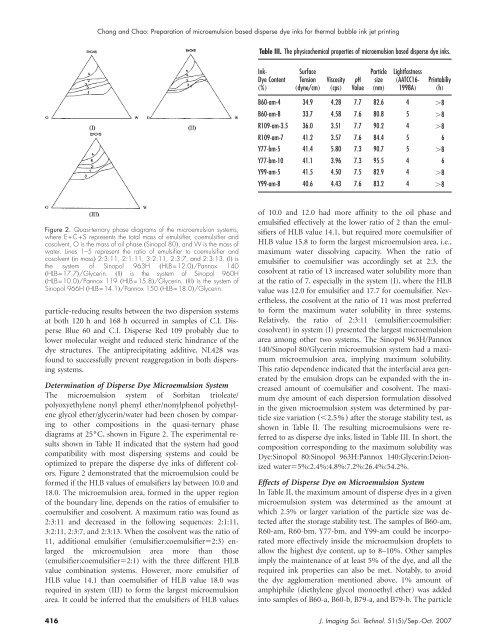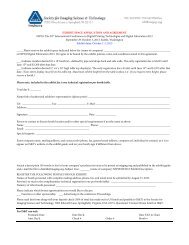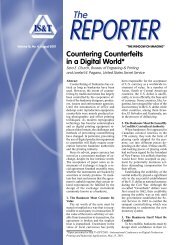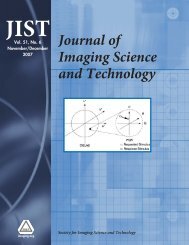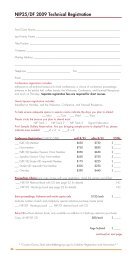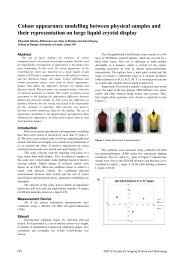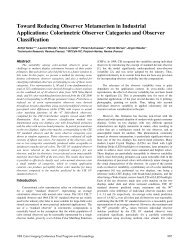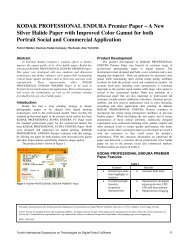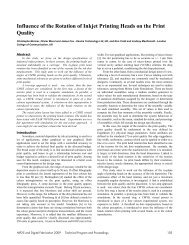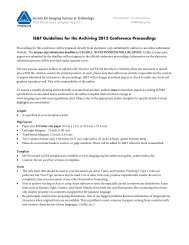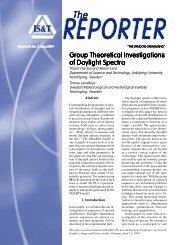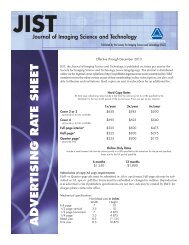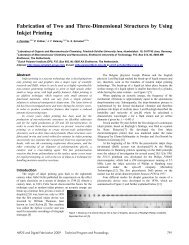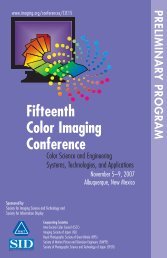JIST - Society for Imaging Science and Technology
JIST - Society for Imaging Science and Technology
JIST - Society for Imaging Science and Technology
Create successful ePaper yourself
Turn your PDF publications into a flip-book with our unique Google optimized e-Paper software.
Chang <strong>and</strong> Chao: Preparation of microemulsion based disperse dye inks <strong>for</strong> thermal bubble ink jet printing<br />
Table III. The physicochemical properties of microemulsion based disperse dye inks.<br />
Ink-<br />
Dye Content<br />
%<br />
Surface<br />
Tension<br />
dyne/cm<br />
Viscosity<br />
cps<br />
pH<br />
Value<br />
Particle<br />
size<br />
nm<br />
Lightfastness<br />
AATCC16-<br />
1998A<br />
Printabiliy<br />
h<br />
B60-am-4 34.9 4.28 7.7 82.6 4 8<br />
B60-am-8 33.7 4.58 7.6 80.8 5 8<br />
R109-am-3.5 36.0 3.51 7.7 90.2 4 8<br />
R109-am-7 41.2 3.57 7.6 84.4 5 6<br />
Y77-bm-5 41.4 5.80 7.3 90.7 5 8<br />
Y77-bm-10 41.1 3.96 7.3 95.5 4 6<br />
Y99-am-5 41.5 4.50 7.5 82.9 4 8<br />
Y99-am-8 40.6 4.43 7.6 83.2 4 8<br />
Figure 2. Quasi-ternary phase diagrams of the microemulsion systems,<br />
where E+C+S represents the total mass of emulsifier, coemulsifier <strong>and</strong><br />
cosolvent, O is the mass of oil phase Sinopol 80, <strong>and</strong>Wisthemassof<br />
water. Lines 1–5 represent the ratio of emulsifier to coemulsifier <strong>and</strong><br />
cosolvent in mass 2:3:11, 2:1:11, 3:2:11, 2:3:7, <strong>and</strong> 2:3:13. I is<br />
the system of Sinopol 963H HLB=12.0/Pannox 140<br />
HLB=17.7/Glycerin. II is the system of Sinopol 960H<br />
HLB=10.0/Pannox 119 HLB=15.8/Glycerin. III is the system of<br />
Sinopol 966H HLB=14.1/Pannox 150 HLB=18.0/Glycerin.<br />
particle-reducing results between the two dispersion systems<br />
at both 120 h <strong>and</strong> 168 h occurred in samples of C.I. Disperse<br />
Blue 60 <strong>and</strong> C.I. Disperse Red 109 probably due to<br />
lower molecular weight <strong>and</strong> reduced steric hindrance of the<br />
dye structures. The antiprecipitating additive, NL428 was<br />
found to successfully prevent reaggregation in both dispersing<br />
systems.<br />
Determination of Disperse Dye Microemulsion System<br />
The microemulsion system of Sorbitan trioleate/<br />
polyoxyethylene nonyl phenyl ether/nonylphenol polyethylene<br />
glycol ether/glycerin/water had been chosen by comparing<br />
to other compositions in the quasi-ternary phase<br />
diagrams at 25°C, shown in Figure 2. The experimental results<br />
shown in Table II indicated that the system had good<br />
compatibility with most dispersing systems <strong>and</strong> could be<br />
optimized to prepare the disperse dye inks of different colors.<br />
Figure 2 demonstrated that the microemulsion could be<br />
<strong>for</strong>med if the HLB values of emulsifiers lay between 10.0 <strong>and</strong><br />
18.0. The microemulsion area, <strong>for</strong>med in the upper region<br />
of the boundary line, depends on the ratios of emulsifier to<br />
coemulsifier <strong>and</strong> cosolvent. A maximum ratio was found as<br />
2:3:11 <strong>and</strong> decreased in the following sequences: 2:1:11,<br />
3:2:11, 2:3:7, <strong>and</strong> 2:3:13. When the cosolvent was the ratio of<br />
11, additional emulsifier (emulsifier:coemulsifier2:3) enlarged<br />
the microemulsion area more than those<br />
(emulsifier:coemulsifier2:1) with the three different HLB<br />
value combination systems. However, more emulsifier of<br />
HLB value 14.1 than coemulsifier of HLB value 18.0 was<br />
required in system (III) to <strong>for</strong>m the largest microemulsion<br />
area. It could be inferred that the emulsifiers of HLB values<br />
of 10.0 <strong>and</strong> 12.0 had more affinity to the oil phase <strong>and</strong><br />
emulsified effectively at the lower ratio of 2 than the emulsifiers<br />
of HLB value 14.1, but required more coemulsifier of<br />
HLB value 15.8 to <strong>for</strong>m the largest microemulsion area, i.e.,<br />
maximum water dissolving capacity. When the ratio of<br />
emulsifier to coemulsifier was accordingly set at 2:3, the<br />
cosolvent at ratio of 13 increased water solubility more than<br />
at the ratio of 7, especially in the system (I), where the HLB<br />
value was 12.0 <strong>for</strong> emulsifier <strong>and</strong> 17.7 <strong>for</strong> coemulsifier. Nevertheless,<br />
the cosolvent at the ratio of 11 was most preferred<br />
to <strong>for</strong>m the maximum water solubility in three systems.<br />
Relatively, the ratio of 2:3:11 (emulsifier:coemulsifier:<br />
cosolvent) in system (I) presented the largest microemulsion<br />
area among other two systems. The Sinopol 963H/Pannox<br />
140/Sinopol 80/Glycerin microemulsion system had a maximum<br />
microemulsion area, implying maximum solubility.<br />
This ratio dependence indicated that the interfacial area generated<br />
by the emulsion drops can be exp<strong>and</strong>ed with the increased<br />
amount of coemulsifier <strong>and</strong> cosolvent. The maximum<br />
dye amount of each dispersion <strong>for</strong>mulation dissolved<br />
in the given microemulsion system was determined by particle<br />
size variation 2.5% after the storage stability test, as<br />
shown in Table II. The resulting microemulsions were referred<br />
to as disperse dye inks, listed in Table III. In short, the<br />
composition corresponding to the maximum solubility was<br />
Dye:Sinopol 80:Sinopol 963H:Pannox 140:Glycerin:Deionized<br />
water5%:2.4%:4.8%:7.2%:26.4%:54.2%.<br />
Effects of Disperse Dye on Microemulsion System<br />
In Table II, the maximum amount of disperse dyes in a given<br />
microemulsion system was determined as the amount at<br />
which 2.5% or larger variation of the particle size was detected<br />
after the storage stability test. The samples of B60-am,<br />
R60-am, R60-bm, Y77-bm, <strong>and</strong> Y99-am could be incorporated<br />
more effectively inside the microemulsion droplets to<br />
allow the highest dye content, up to 8–10%. Other samples<br />
imply the maintenance of at least 5% of the dye, <strong>and</strong> all the<br />
required ink properties can also be met. Notably, to avoid<br />
the dye agglomeration mentioned above, 1% amount of<br />
amphiphile (diethylene glycol monoethyl ether) was added<br />
into samples of B60-a, B60-b, B79-a, <strong>and</strong> B79-b. The particle<br />
416 J. <strong>Imaging</strong> Sci. Technol. 515/Sep.-Oct. 2007


